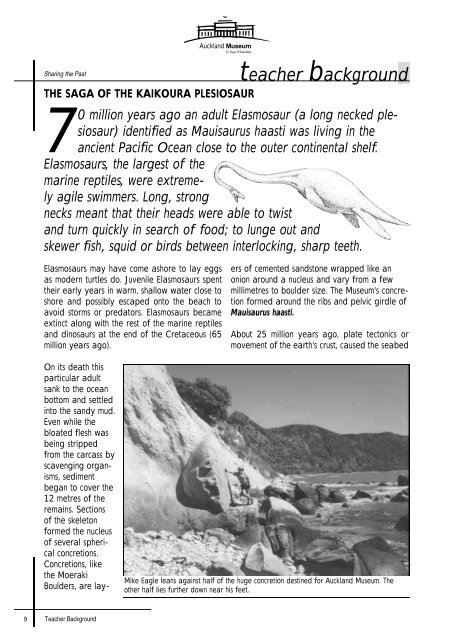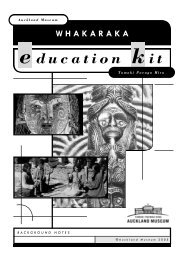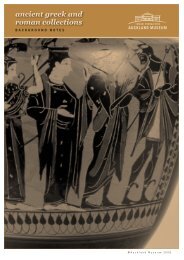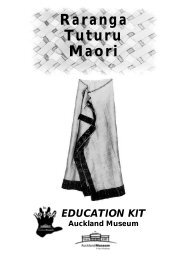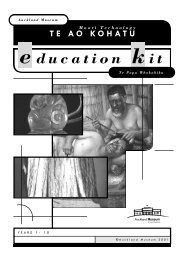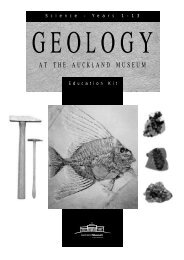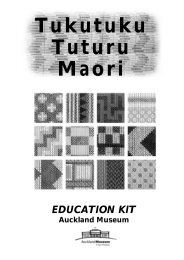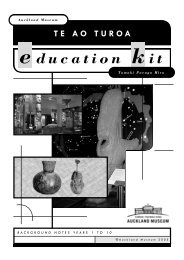You also want an ePaper? Increase the reach of your titles
YUMPU automatically turns print PDFs into web optimized ePapers that Google loves.
Sharing <strong>the</strong> Past<br />
Elasmosaurs may have come ashore to lay eggs<br />
as modern turtles do. Juvenile Elasmosaurs spent<br />
<strong>the</strong>ir early years in warm, shallow water close to<br />
shore and possibly escaped onto <strong>the</strong> beach to<br />
avoid storms or predators. Elasmosaurs became<br />
extinct along with <strong>the</strong> rest of <strong>the</strong> marine reptiles<br />
and dinosaurs at <strong>the</strong> end of <strong>the</strong> Cretaceous (65<br />
million years ago).<br />
On its death this<br />
particular adult<br />
sank to <strong>the</strong> ocean<br />
bottom and settled<br />
into <strong>the</strong> sandy mud.<br />
Even while <strong>the</strong><br />
bloated flesh was<br />
being stripped<br />
from <strong>the</strong> carcass by<br />
scavenging organisms,<br />
sediment<br />
began to cover <strong>the</strong><br />
12 metres of <strong>the</strong><br />
remains. Sections<br />
of <strong>the</strong> skeleton<br />
formed <strong>the</strong> nucleus<br />
of several spherical<br />
concretions.<br />
Concretions, like<br />
<strong>the</strong> Moeraki<br />
Boulders, are lay-<br />
9 Teacher Background<br />
<strong>Auckland</strong> <strong>Museum</strong><br />
Te Papa Whakahiku<br />
THE SAGA OF THE KAIKOURA PLESIOSAUR<br />
teacher background<br />
70 million years ago an adult Elasmosaur (a long necked plesiosaur)<br />
identified as Mauisaurus haasti was living in <strong>the</strong><br />
ancient Pacific Ocean close to <strong>the</strong> outer continental shelf.<br />
Elasmosaurs, <strong>the</strong> largest of <strong>the</strong><br />
marine reptiles, were extremely<br />
agile swimmers. Long, strong<br />
necks meant that <strong>the</strong>ir heads were able to twist<br />
and turn quickly in search of food; to lunge out and<br />
skewer fish, squid or birds between interlocking, sharp teeth.<br />
ers of cemented sandstone wrapped like an<br />
onion around a nucleus and vary from a few<br />
millimetres to boulder size. The <strong>Museum</strong>'s concretion<br />
formed around <strong>the</strong> ribs and pelvic girdle of<br />
Mauisaurus haasti.<br />
About 25 million years ago, plate tectonics or<br />
movement of <strong>the</strong> earth's crust, caused <strong>the</strong> seabed<br />
Mike Eagle leans against half of <strong>the</strong> huge concretion destined for <strong>Auckland</strong> <strong>Museum</strong>. The<br />
o<strong>the</strong>r half lies fur<strong>the</strong>r down near his feet.


